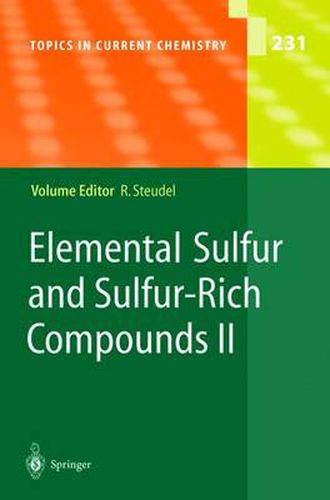Readings Newsletter
Become a Readings Member to make your shopping experience even easier.
Sign in or sign up for free!
You’re not far away from qualifying for FREE standard shipping within Australia
You’ve qualified for FREE standard shipping within Australia
The cart is loading…






This title is printed to order. This book may have been self-published. If so, we cannot guarantee the quality of the content. In the main most books will have gone through the editing process however some may not. We therefore suggest that you be aware of this before ordering this book. If in doubt check either the author or publisher’s details as we are unable to accept any returns unless they are faulty. Please contact us if you have any questions.
Despite more than 200 years of sulfur research the chemistry of elemental sulfur and sulfur-rich compounds is still full of white spots which have to be filled in with solid knowledge and reliable data. This situation is parti- larly regrettable since elemental sulfur is one of the most important raw - terials of the chemical industry produced in record-breaking quantities of ca. 35 million tons annually worldwide and mainly used for the production of sulfuric acid. Fortunately, enormous progress has been made during the last 30 years in the understanding of the yellow element . As the result of extensive inter- tional research activities sulfur has now become the element with the largest number of allotropes, the element with the largest number of binary oxides, and also the element with the largest number of binary nitrides. Sulfur, a typical non-metal, has been found to become a metal at high pressure and is even superconducting at 10 K under a pressure of 93 GPa and at 17 K at 260 GPa, respectively. This is the highest critical temperature of all chemical elements. Actually, the pressure-temperature phase diagram of sulfur is one of the most complicated of all elements and still needs further investigation.
$9.00 standard shipping within Australia
FREE standard shipping within Australia for orders over $100.00
Express & International shipping calculated at checkout
This title is printed to order. This book may have been self-published. If so, we cannot guarantee the quality of the content. In the main most books will have gone through the editing process however some may not. We therefore suggest that you be aware of this before ordering this book. If in doubt check either the author or publisher’s details as we are unable to accept any returns unless they are faulty. Please contact us if you have any questions.
Despite more than 200 years of sulfur research the chemistry of elemental sulfur and sulfur-rich compounds is still full of white spots which have to be filled in with solid knowledge and reliable data. This situation is parti- larly regrettable since elemental sulfur is one of the most important raw - terials of the chemical industry produced in record-breaking quantities of ca. 35 million tons annually worldwide and mainly used for the production of sulfuric acid. Fortunately, enormous progress has been made during the last 30 years in the understanding of the yellow element . As the result of extensive inter- tional research activities sulfur has now become the element with the largest number of allotropes, the element with the largest number of binary oxides, and also the element with the largest number of binary nitrides. Sulfur, a typical non-metal, has been found to become a metal at high pressure and is even superconducting at 10 K under a pressure of 93 GPa and at 17 K at 260 GPa, respectively. This is the highest critical temperature of all chemical elements. Actually, the pressure-temperature phase diagram of sulfur is one of the most complicated of all elements and still needs further investigation.